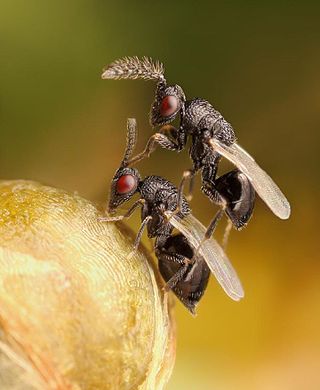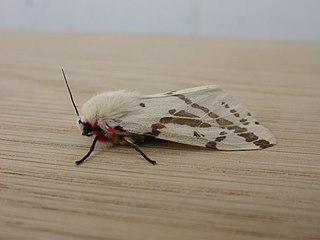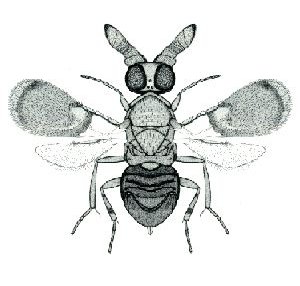Related Research Articles

Chalcid wasps are insects within the superfamily Chalcidoidea, part of the order Hymenoptera. The superfamily contains some 22,500 known species, and an estimated total diversity of more than 500,000 species, meaning the vast majority have yet to be discovered and described. The name "chalcid" is often confused with the name "chalcidid", though the latter refers strictly to one constituent family, the Chalcididae, rather than the superfamily as a whole; accordingly, most recent publications (e.g.,) use the name "chalcidoid" when referring to members of the superfamily.

The Eurytomidae are a family within the superfamily Chalcidoidea.

Ardices canescens, the dark-spotted tiger moth or light ermine moth, is a moth in the family Erebidae that is found across most of Australia. It originally was included in the genus Spilosoma, but later the generic status of Ardices was proven.

Tamarixia is a genus of hymenopteran insects of the family Eulophidae, they are parasitoids of Jumping plant lice or psyllids of the superfamily Psylloidea, although some species will parasitise aphids. Most species appear to be ectoparasitoids but at least one species has been recorded as an endoparasitoid.

Coccophagus is a large genus of chalcid wasps belonging to the family Aphelinidae.

Anagyrus is a large genus of parasitic wasps from the family Encyrtidae. Anagyrus is distributed throughout the world. A subgenus of Anagyrus is known as Nesoanagyrus
Aphytis is a genus of chalcid wasps in the family Aphelinidae. There are about 130 species.

Ablerus is the only genus in the family Azotidae. The genus was created by the American entomologist Leland Ossian Howard in 1894 for the species named in that year by William Harris Ashmead as Centrodora clisiocampae. The genus Azotus was synonymized with Ablerus by Alexandre Arsène Girault in 1913 and Hyatt synonymized Myocnemella with Ablerus in 1994, leaving Ablerus as the sole genus within the subfamily Azotinae. Azotinae was elevated in rank in 2013 to become the monotypic family Azotidae.

Encyrtinae is a subfamily of parasitic wasps in the family Encyrtidae.

Anicetus is a parasitic wasp genus in the subfamily Encyrtinae.

Cleonymus is a genus of wasps in the family Cleonymidae.

Entedoninae is a subfamily of wasps in the family Eulophidae. The subfamily includes over 90 genera.

Psyllaephagus is a genus of chalcid wasps. It was named and circumscribed by William Harris Ashmead in 1900. As of 2019, Psyllaephagus contains approximately 245 species. They are found worldwide: Australia has 100 described species; the Palaearctic region has about 57 species, India has about 20, and Africa about 30.

Conura is a genus of chalcidid wasps in the family Chalcididae, containing more than 300 species described. They are distributed mostly in the New World, especially in the Neotropical region, where 279 species occur. Conura is divided into three subgenera and 63 species groups, which may not form taxonomic entities but reflect patterns of morphology that are useful for focused studies.
A list of the species of Hymenoptera from New Zealand; which includes ants, bees, parasitoids, sawflies, and social wasps.
Syrphophagus is a genus of wasps belonging to the family Encyrtidae.
References
- ↑ Noyes, John S. (June 2012). "Species in genus Copidosoma". Universal Chalcidoidea Database. Natural History Museum, London . Retrieved 5 January 2021.